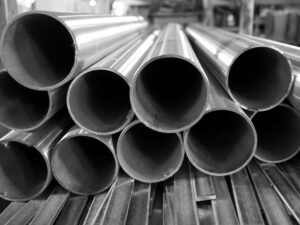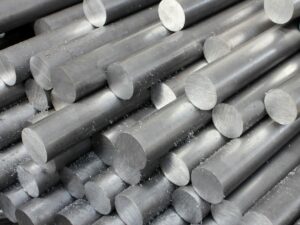Ever pondered why certain metals are preferred over others in diverse industries? Metals are renowned for its unique attributes and wide application scope, possess individual pros and cons that can make or break the efficacy of a project. Ever scratched your head over the dichotomy between stainless steel and titanium?
Whether it’s about high corrosion resistance or optimal strength-to-weight ratio, the right choice can make a significant difference. This article promises an in-depth comparison between stainless steel and titanium, aiming to help you gain clear insights, thus resolving the long-standing conundrum.
Buckle up, and let’s dive in!
1. Basic Introduction to Metals
Delving into the world of metals unveils a vast array of substances that make up a significant portion of the earth and play crucial roles in diverse areas of life. Let’s delve into the basic introduction of metals:
Definition of Metals
Metals, in the broadest sense, are elements that typically exhibit lustrous appearance, good thermal and electrical conductivity, malleability, and ductility. Generally found in the left and center of the periodic table, showcasing its unique characteristics and wide distribution across different groups of elements. One classic example of metal is iron; a good conductor of heat and electricity, embodying the characteristics of metals.
Classification of Metals
Metals can be classified into several types based on their physical and chemical properties, including ferrous and non-ferrous metals, base and precious metals, and heavy and light metals. Ferrous metals, such as iron and steel, contain iron and are magnetic, while non-ferrous metals, such as aluminum and copper, do not contain iron and are usually more resistant to corrosion.
According to a study in Science Direct, the demand for non-ferrous metals is on a continuous rise due to their resistance to rust and lightweight nature. In my perspective, it’s incredible to realize how these elements, with their varying properties, form the backbone of modern civilization.
Physical Properties of Metals
- Luster: Metals exhibit a characteristic shine or luster due to their ability to reflect light. This property makes them visually appealing and aesthetically valuable.
- Malleability: Metals can be easily hammered or rolled into thin sheets without breaking. This property allows for shaping and forming them into different structures or designs.
- Ductility: Metals possess the ability to be drawn into thin wires without fracturing. This property is essential for the production of electrical wires and cables.
- Conductivity: Metals are excellent conductors of both electricity and heat. Their high electrical conductivity enables the efficient flow of electrical current, while their thermal conductivity allows for effective heat transfer.
Chemical Properties of Metals
-
Reactivity: Metals can exhibit different levels of reactivity. Some metals, such as alkali metals like sodium and potassium, are highly reactive and easily react with water or oxygen. Others, like gold and platinum, are less reactive and do not readily undergo chemical reactions.
-
Oxidation: Many metals have the tendency to react with oxygen in the air, resulting in the formation of metal oxides. This process is commonly known as oxidation and can lead to the corrosion or tarnishing of metals.
-
Reaction with acids: Some metals, such as magnesium and zinc, can react with acids to produce hydrogen gas and salts. This property is utilized in various chemical reactions and industries. In my many years as a researcher, I’ve found this reactivity to be a beautiful dance of chemistry, always fascinating and full of surprises.
-
Electrochemical properties: Metals can participate in electrochemical reactions, such as oxidation-redox (redox) reactions. This property is exploited in batteries and electroplating processes.
Uses and Applications of Metals
-
Construction: Metals like iron and steel are extensively used in construction due to their strength, durability, and structural integrity. They form the backbone of buildings, bridges, and infrastructure projects.
-
Electronics and electrical engineering: Metals, particularly copper and aluminum, are widely employed in electrical wiring and circuitry due to their excellent conductivity. They ensure efficient transmission of electricity in various devices and power systems.
-
Transportation: Metals such as aluminum and titanium find applications in the aerospace and automotive industries. Their lightweight nature, combined with strength and corrosion resistance, makes them ideal for aircraft, automobiles, and spacecraft.
-
Medicine and healthcare: Certain metals, like titanium and stainless steel, are used in medical implants, surgical instruments, and prosthetics due to their biocompatibility, strength, and resistance to bodily fluids.
-
Jewelry and decoration: Precious metals such as gold, silver, and platinum are highly valued for their aesthetic appeal and resistance to tarnishing. They are extensively used in jewelry, decorative items, and luxury goods, including the elegant range of accessories offered by Suproto.
2. The Basics of Stainless Steel
Properties of Stainless Steel
Understanding the characteristics of stainless steel is vital to appreciating its wide-ranging utility. These properties include corrosion resistance, strength and durability, heat resistance, and hygienic properties.
-
Corrosion resistance: Stainless steel is famed for its exceptional corrosion resistance. The chromium in stainless steel reacts with oxygen in the atmosphere to form a thin, invisible layer of chrome-containing oxide, which makes it resistant to water and air. This property is critical in harsh environmental conditions and contributes to the long life span of stainless steel structures.
-
Strength and durability: Stainless steel is renowned for its strength and durability. It is a robust material that can withstand substantial stress, making it ideal for numerous heavy-duty applications. The durability of stainless steel also contributes to its low maintenance requirement, as cited in an academic review.
-
Heat resistance: High-temperature applications favor stainless steel due to its excellent heat resistance. It can maintain its strength at high temperatures, making it suitable for use in environments such as boilers and pressure vessels. It confirmed the superior heat-resistant characteristics of stainless steel, especially the austenitic type.
-
Hygienic properties: Stainless steel’s non-porous surface makes it a top choice for applications where hygiene is a priority, such as medical instruments and food preparation areas. Its ease of cleaning and the ability to resist bacterial growth are two of its critical hygienic properties.
Types and Grades of Stainless Steel
Stainless steel isn’t just a single type of material but a family of corrosion-resistant steels. We will discuss four main types of stainless steel.
-
Austenitic stainless steel: The most widely used type of stainless steel, austenitic stainless steel contains high levels of nickel and chromium, which provide excellent corrosion resistance and good mechanical properties. In my extensive research, exploring different metals, only these are the types of metal that truly fascinate me.
-
Ferritic stainless steel: Containing lower amounts of nickel and higher amounts of chromium, ferritic stainless steels are magnetic and have good corrosion resistance and formability. For instance, they are commonly used in automotive applications.
-
Martensitic stainless steel: These are the least corrosion-resistant but most hardenable stainless steels, offering a good balance between cost, strength, and corrosion resistance. They are often employed in the creation of cutlery and surgical tools.

Applications of Stainless Steel
Stainless steel has proven to be a versatile material that caters to various industry demands. From architecture to healthcare, its wide array of applications is a testament to its adaptable properties.
-
Architecture and construction: The strength, corrosion resistance, and aesthetic appeal of stainless steel make it a popular choice in architecture and construction. It is used in both structural applications and design elements.
-
Food and beverage industry: Due to its hygienic properties, stainless steel is commonly used in the food and beverage industry. It’s found in kitchen utensils, appliances, and industrial food processing equipment.
-
Medical and healthcare: Stainless steel’s resistance to corrosion, ease of sterilization, and durability make it an ideal material for medical devices like surgical instruments, implants, and hospital equipment.
-
Automotive and transportation: With its strength and resistance to corrosion, stainless steel is used in various parts of vehicles, from exhaust systems to car grills.
-
Energy and heavy industries: In the energy sector, stainless steel is used due to its resistance to heat and corrosion, especially in harsh conditions like oil and gas extraction sites. Drawing on my years of experience in the industry, I admire the grit and resilience of this material.
3. The Basics of Titanium
Titanium, known for its strength and versatility, holds a significant role in various fields. Derived from its ore, it is a metal that combines high strength, lightness, and exceptional resistance to corrosion. This guide aims to delve into the key aspects of titanium, including its properties, uses, and how it’s processed.

Properties of Titanium
Titanium possesses some remarkable attributes that make it a desirable material in different industries. We will explore four key properties of titanium:
-
Strength and lightweight: Titanium is renowned for its impressive strength-to-weight ratio. It is as strong as steel but approximately 45% lighter. This unique property makes it ideal for applications where strength and minimal weight are paramount, for instance, in aerospace engineering.
-
Corrosion resistance: Sage Publications highlighted that titanium is reported to be highly resistant to general corrosion in seawater. This attribute extends the lifespan of titanium products and reduces maintenance costs, which is particularly valuable in industrial and marine applications.
-
Heat resistance: Titanium retains its strength even at high temperatures, a critical factor in fields like aerospace and automotive, where materials must withstand heat-intensive conditions. My fascination with high-temperature materials leads me to appreciate titanium’s heat resistance.
-
Biocompatibility: Another remarkable characteristic of titanium is its biocompatibility. Titanium doesn’t react with the human body, which makes it suitable for medical applications, such as surgical implants.
Uses and Applications of Titanium
With a firm understanding of titanium’s properties, we can now explore how these translate into practical applications. We’ll examine the use of titanium in the top performing industries:
-
Aerospace industry: Due to its high strength, low weight, and heat resistance, titanium is widely used in the aerospace industry. For example, the Concorde supersonic plane had heat-proof titanium skin. It’s often used in aircraft frames and engines.
-
Medical and healthcare: Titanium’s biocompatibility makes it a material of choice for many medical applications. It is commonly used for surgical implants like hip and knee replacements.
-
Chemical and industrial applications: Titanium’s corrosion resistance makes it useful in chemical and industrial settings. It’s often employed in piping and heat exchangers in industries such as oil and gas, where corrosion can be a significant issue.
-
Consumer products: In consumer goods, titanium is used in items such as eyeglasses and watches, which benefit from its durability and light weight.
-
Architecture and construction: In construction, titanium’s resistance to corrosion makes it ideal for structures exposed to the elements, like bridges, or for design features in modern architecture. Manufacturers like Suproto, with its innovative use of titanium, continue to redefine the standards in this domain.
Production and Processing of Titanium
Titanium’s extraction and processing involve several stages, from the initial mining of titanium ore to the final fabrication of titanium products. Let’s take a closer look at its productions and process below:
-
Step#1 extraction of titanium: The extraction process involves mining titanium ore, which is primarily composed of minerals such as rutile and ilmenite. Once mined, the ore undergoes an extraction process to retrieve the valuable titanium dioxide.
-
Step#2 reduction of titanium ore: Titanium ore is reduced to produce titanium sponge, which is a raw form of titanium. This process typically involves the Kroll process, which treats
titanium tetrachloride with magnesium to produce titanium.
-
Step#3 refining and purification: The raw titanium is then refined and purified to remove any impurities. This is a crucial stage in ensuring the quality and purity of the final titanium product.
-
Step#4 alloying and melting: Pure titanium is often alloyed with other metals to enhance specific properties based on the intended application. After alloying, the titanium is melted in a vacuum to prevent contamination.
-
Step#5 forming and fabrication: Finally, the titanium is formed into the desired shapes through processes such as forging, casting, or machining. I’ve always found this transformative stage thrilling.
4. In-depth Comparison: Stainless Steel vs Titanium
Understanding the characteristics and applications of two commonly used materials, Stainless Steel and Titanium, is critical in making informed decisions in various industrie. Both metals have unique properties that make them preferred choices in many applications. To facilitate a better understanding of these two metals, we will present their properties and uses in a comparative table.
| Properties |
Stainless Steel |
Titanium |
| Element Composition |
Alloy of iron, chromium, and other metals, with at least 10.5% chromium by mass and a maximum of 1.2% carbon by mass |
Commercially pure titanium contains a variety of elements including nitrogen, hydrogen, oxygen, carbon, iron, and nickel, with titanium being the major element |
| Corrosion Resistance |
High, especially with increasing chromium content |
High, particularly resistant to corrosion in seawater and chlorine environments |
| Weight |
Heavier compared to titanium |
Lighter, contributing to a high strength-to-weight ratio |
| Thermal Conductivity |
Relatively low |
Good, making it suitable for use in heat exchangers or cryogenic tanks |
| Strength-to-Weight Ratio |
High |
Higher than stainless steel, making it ideal for applications where weight savings are important |
| Cost |
Relatively inexpensive and widely available |
More expensive due to its unique properties |
In my opinion, the decision between stainless steel and titanium should always be dictated by the specific requirements of the application in question. Note that the properties presented on the table are just some of the properties that these metals have in common.
5. Factors To Consider When Choosing Between Stainless Steel or Titanium
Choosing between stainless steel and titanium for any application is no small task. Both materials offer unique strengths and weaknesses, thereby making their appropriateness a matter of the intended use, environment, and many other factors. In the quest to identify the right material for every need, we delve into six critical factors that may influence every decision.
#1 Cost
Cost is a significant factor in any decision-making process. Titanium is typically more expensive than stainless steel due to its processing complexity and unique properties, like strength and low weight. Stainless steel, being widely available and easier to work with, is relatively inexpensive and more economically sustainable for most uses.
#2 Weight
When it comes to weight considerations, titanium has a notable edge over stainless steel. Despite being sturdy, it is significantly lighter than stainless steel, which may be a critical consideration for applications like aerospace, where weight savings are significant. As someone who values efficiency, I find this aspect of titanium absolutely intriguing.
#3 Corrosion Resistance
Stainless steel and titanium are known for their corrosion resistance, but the environments they each withstand vary. While stainless steel is highly resistant to corrosion in general, titanium particularly shines in resisting corrosion from thermoforming, seawater and chlorine environments, proving beneficial in maritime applications.
#4 Strength-to-Weight Ratio
This is a crucial factor in industries where strength and weight play a significant role, like aviation and construction. Both materials have a high strength-to-weight ratio, but according to Send Cut Send, titanium is a lightweight–in, in the best possible sense with the highest strength-to-weight ratio of any metallic element.
#5 Thermal Conductivity
The ability of a material to conduct heat could be pivotal, depending on its intended use. While stainless steel excels with the properties that it has, titanium also has a good thermal conductivity which makes it suitable for use in heat exchangers or cryogenic tanks, stated by The Piping Mart. As a heat transfer enthusiast, this attribute of titanium genuinely excites me.
Dive Deeper Into Our Resources
Looking for more diverse service options? Browse through our handpicked selections:
Still haven’t found what you’re looking for? Don’t hesitate to contact us. We’re available around the clock to assist you.
Conclusion
In the grand battle between stainless steel and titanium, both contenders have put up a vigorous fight. With my decades-long fascination and engagement with the world of metallurgy, I always find these comparisons exciting and illuminating.
If you have further inquiries about stainless steel, titanium, or any other material, I’d love for you to get in touch with us. Your project’s success is our top priority, and we’re here to help answer any questions or provide more product details. Please don’t hesitate to
contact us today.





